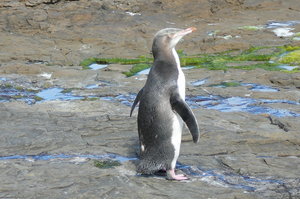Advertisement
Published: December 13th 2012

 Yellow Eyed Penguin
Yellow Eyed Penguin
Where's he gone to now?We camped Tuesday night on the headland between two bays; Porpoise Bay and Curio Bay. This was the most idyllic of sites we have stayed in so far; miles from anywhere and really back to nature which is all around. Though we were not fortunate to see the dolphins that swim around the headland, we did meet up with some very rare Yellow-eyed penguins that nest in Curio Bay. There are only 6 nests in total in this area but we managed to see 4 juvenile birds later in the afternoon and early in the morning. Facilities at the campsite were very basic as you can imagine but we have excellent facilities with us and managed to survive! With no light pollution the stars of the Southern Hemisphere were a sight to behold.
But the real interest for me was the 180 million year of petrified forest which is recognised as one of the finest examples of a Jurassic Forest in the world. The Curio Bay area was once a broad coastal floodplain during the middle Jurassic when New Zealand was part of the ancient continent of Gondwana. The forest predominantly consisted of trees forming a low canopy over an
undergrowth of ferns.
During heavy rainfall a series of floods carrying volcanic ash from a nearby volcano (lahars) destroyed the forest only for it to grow back again on the new surface. This cycle appears to have happened at least 4 times as there are 4 successive layers visible. What remains are the fossilised stumps, some still showing their roots in some cases together with large tree trunks, some of which I measured at over 30 metres. Preservation is perfect and you can still identify the wood grain and knots. Preservation is by silica replacement where the original carbon of the tree has been replaced atom by atom with silica (quartz) to form a very resistant fossil which looks exactly like the original. Sue commented that it looks like you could even get splinters if you are not careful.
Along the shore of the current bay there is a present day living forest with a similar structure to the original fossil forest of Masai and Totara trees which are probable descendents of those preserved.
A truely outstanding geological place to study, and with obliging penguins to act as scales for the photographs!
Advertisement
Tot: 0.084s; Tpl: 0.013s; cc: 11; qc: 48; dbt: 0.0481s; 1; m:domysql w:travelblog (10.17.0.13); sld: 1;
; mem: 1.1mb

 Yellow Eyed Penguin
Yellow Eyed Penguin




